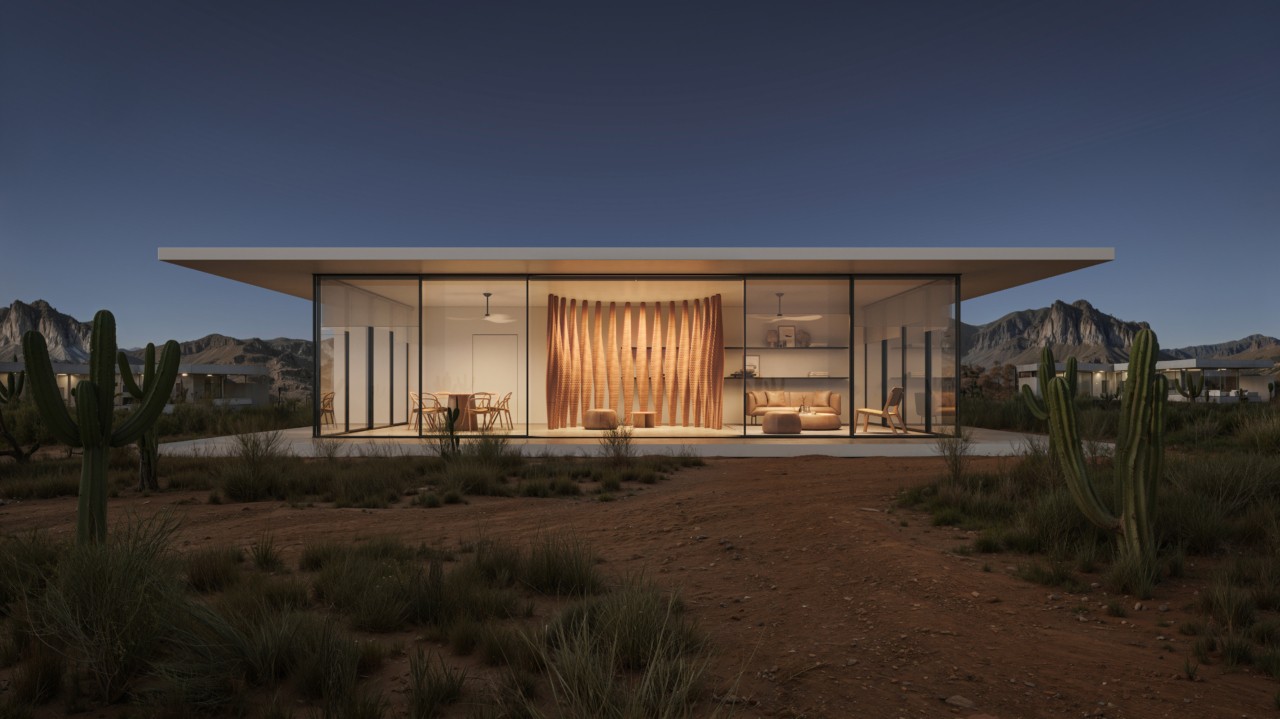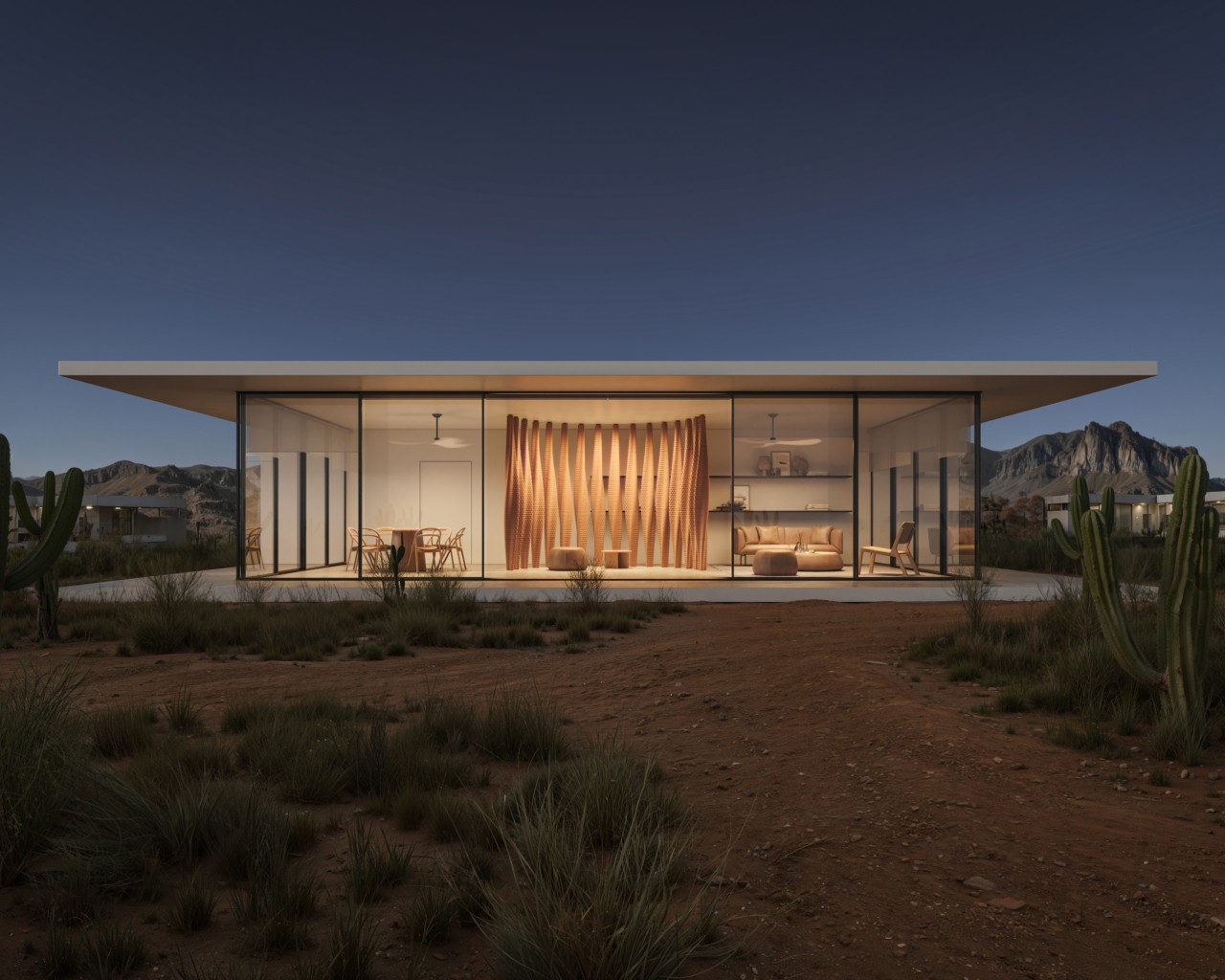

Words by Yasmin Alrabiei
As the planet warms, cities are straining under the weight of their own design.
Glass towers trap sunlight, turning themselves into greenhouses, as sealed interiors choke off natural airflow, and concrete radiates the day’s trapped heat back into the night. Among the many climate crises unfolding, none is more immediate than heat: In 2024—the hottest year on record—buildings themselves began to buckle under new extremes with materials expanding, cracking, and straining beyond their design limits.
I know this to be true firsthand. When I visited my family in Baghdad in June 2023, the heat felt less like weather and more like a second atmosphere pressing on my skin. Around me, uninsulated concrete walls and flat roofs absorbed and radiated the glare. Relief came only in the hum of air conditioners, which we relied on like oxygen. In the quiet between their cycles, I wondered how anyone ever endured this heat without machines.
For much of the modern era, African and Middle Eastern cities imported foreign styles ill-suited to their climates. Concrete towers and glass facades erased local wisdom that had evolved to work with heat, not against it. Architecture, like maps, reflects power: Eurocentric cartography flattened the world into grids of conquest and commerce, and dominant building models likewise stripped regions of their ecological intelligence. Today, that pattern is finally shifting. At a recent Venice Architecture Biennales, more than half the participants were from Africa or its diaspora, spotlighting Indigenous systems shaped by a respect for the elements.
Architects, too, are turning to earlier societies for lessons on staying cool. Stefan Al, an architect and designer who owns his own firm, argues that all architecture curriculum should include the study of “the first cities of Mesopotamia [modern day Iraq], like Ur” to learn how clay is “both symbolically rich and practically ideal for sustainable, future-facing design.” With that ethos—listening to what the Earth already offers—Al and industrial designer Brook Kennedy have developed a 3D-printed ceramic partition wall that passively cools air through evaporation.
The structure draws on centuries-old knowledge from the SWANA region. One model is the North African zeer pot: two nested clay pots separated by wet sand. As air moves across the surface, evaporation chills the inner pot enough to preserve vegetables for weeks. The designers also looked to Muscatese windows, common throughout the region. These climate-smart wooden window screens merge intricate latticework with the mashrabiya, an Islamic architectural element that provides privacy, ventilation, dappled light, and passive cooling in a single decorative façade.
Using local clay and a ceramic 3D printer, the team built porous column modules packed with sand and water. Like a scaled-up zeer pot, air cools as it passes over the moist surface. At Virginia Tech University, they even mixed in wood dust and crushed clam shells from the state’s Eastern Shore, which increased porosity and improved evaporation. The result is a material structure that breathes and cools with age-old intelligence.
“I believe that cross-breeding ancient passive principles with contemporary design tools is one of the most promising paths forward.”
Kennedy frames the work as a rebuttal to what he calls innovationism: “the technocratic assumption that new technologies are inherently superior,” the designer said. For him, the duo’s innovative structure proves how much can be reclaimed from so-called archaic systems when treated as models for the future.
Al extends that argument through clay itself, stressing “its ubiquity, insulating properties, and most importantly, low embodied carbon,” he said. The material posed challenges in Virginia’s humidity, but 3D printing turned those limits into assets: ripple-like surfaces that enhance passive cooling, while echoing the organic curves people instinctively prefer. “Research suggests humans are drawn to curves over rectilinear forms,” said Al. “Perhaps because they echo nature.”
Engineering is often treated as synonymous with modern technology, but its roots stretch back to ancient cities like Yazd in central Iran. Iranian-American writer Shervin Abdolhamidi calls windcatchers “an ancient engineering feat that harnessed the wind,” linking Iraq’s 8th century Abbasid palaces to Yazd’s rooftops. Known as bâdgir in Iran, these towers allegedly date back as far as 4000 BC. They ventilated buildings by funnelling breezes through narrow shafts and expelling hot air, often oriented with four or eight sides to capture winds from Isfahan. Some even cooled underground water cisterns–qanats, now a UNESCO World Heritage site–to near-freezing temperatures during summer heat.
“Elders in Yazd often lament the loss of traditional design that served them for centuries, now replaced by universal modernism” Abdolhamidi said. “One woman remarked that her daughter’s house with air-conditioning is hotter in the evenings than hers, with only a windcatcher.”
Modern iterations exist, too. At Princess Nora University in Riyadh, Saudi Arabia, courtyards are ventilated by windcatchers adapted with misted surfaces. “I believe that cross-breeding ancient passive principles with contemporary design tools is one of the most promising paths forward,” said Radwan Elkassir, the mechanical engineering professor who led the project. The evaporative system reduced energy use dramatically, with only 1% consumed for pumping water.
That efficiency points to a deeper truth: there is no new water on Earth. Human mortality may be inevitable, but water is endlessly renewed, circulating through clouds, rivers, aquifers. Indigenous passive cooling techniques are, in essence, a communion with that cycle.
A similar revival is taking place across Africa. In the scorching heat of Burkina Faso, a laterite-stone mausoleum maintains a chilled interior using only passive ventilation and local materials. Designed by Diébédo Francis Kéré–who in 2022 became the first Black recipient of the Pritzker Prize–it reflects a growing movement to build sustainably and affordably. Kéré credits Burkina Faso’s former president Thomas Sankara, a champion of national self-sufficiency, as a guiding influence.
Egyptian architect Marwa Dabaieh recalls a turning point during her doctorate with Indigenous communities in the country’s western desert: “They taught me more than any textbook about regenerative, rooted design.” Now internationally recognized for her work in zero-emission architecture, Dabaieh applies that wisdom through low-tech cooling systems—such as traditional shisha clay funnels in Egypt and Namibia—shown to cut indoor temperatures by 9 degrees Fahrenheit (5 degrees Celsius) and humidity by 40%.
“What if our biophilic instincts draw us to homes that breathe with the land? What futures might we build from clay and wind?”
Central to Dabaieh’s approach is a design science called BioGeometry® that is informed by sacred geometry, geomancy, and environmental harmony drawn from Islamic and Ancient Egyptian traditions. “It helps reframe comfort not only as thermal, but as energetic, beyond rigid performance metrics” she added. For Dabaieh, that philosophy echoes a larger truth: Vernacular architecture carries its own spiritual weight in the way it aligns local culture with the surrounding ecosystem by both harnessing and preserving nature. While techno-utopian headlines often echo Hollywood sci-fi, true climate-adapted design requires only the humility to learn from the past.
The Egyptian architect Hassan Fathy made that argument decades ago. “When they say ‘futuristic,’ they really mean: building according to their dreams,” he observed. Fathy resisted the drift toward global sameness, warning that glass towers may suit the United States, but in Kuwait their wholesale adoption created such solar load that buildings required two metric tons of refrigeration per hour to stay habitable. His seminal Architecture for the Poor championed Nubian mudbrick homes designed as climate resilient alternatives. Grounded in Islamic reverence for nature, he wrote, “every God-fashioned thing from the elephant to the ant to the atom is beautiful,” urging architecture that balances, rather than dominates, its environment.
This ethic endures in his protégé Abdel Wahed El-Wakil who calls courtyards, with their self-contained microclimates, “the soul of the house.” He, too, drew on Islamic belief that humankind was formed of clay. “You are building with the material God created you with. We all go back to earth as we came from Earth,” he said in the documentary Abdel-Wahed El-Wakil: Portrait of an Architect.
Beyond metaphor, it is what today’s language of biophilia gestures toward: an ancient intuition that humans are wired to seek connection with the natural world. Like Al and Kennedy’s embrace of clay, the future of sustainable design may lie in returning to the Earth that first taught us how to build.
What if our biophilic instincts draw us to homes that breathe with the land? What futures might we build from clay and wind? Passive cooling endures precisely because it is climate-specific, not universal. As Kennedy notes, it thrives in dry heat, but in humid air already saturated with moisture, evaporation slows. Still, where conditions allow, the gains—especially in energy savings—are profound.
The answer to rising heat may not lie in the shiny promises of techno-futurism, but in organic technologies that predate us by over 4,000 years. Salt, clay, water, shadow, breeze—ancient sciences, far wiser than modern hubris. Clay, after all, is earth that remembers. It holds the shape of what has touched it; it is history made malleable, and perhaps a way to secure our future.
The Future of Cooling Was Invented Thousands of Years Ago